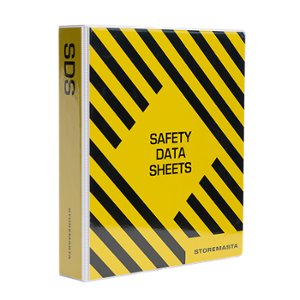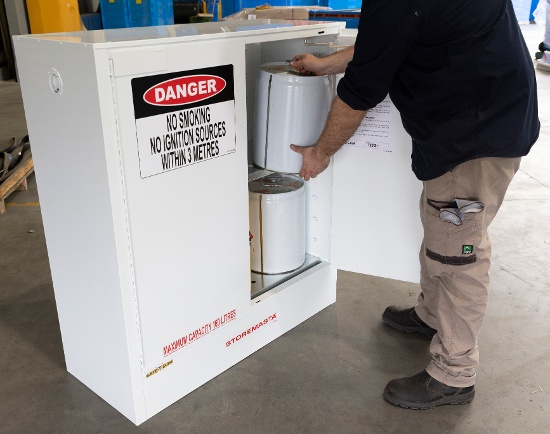While the name gives it away, toxic substances are Division 6.1 dangerous goods that may cause harm, serious injury or fatalities to humans and other living organisms. Due to their potential for harm, toxic substances require specific handling and storage procedures to maintain health and safety.
Toxic substances are found across a broad range of industries including medical, manufacturing, agriculture and education. They may include pesticides, chloroform, arsenics, cyanides and hydrocyanic acid.
To help you and your team stay safe while working with toxic substances, we’ve compiled a list of simple ‘don’ts’ so you can avoid chemical accidents in your workplace. But first, let’s look at some instances where toxic chemicals can cause harm to those working with them.
Examples of Accidents with Toxic Substances
There are many ways in which harm can occur when staff are handling and storing toxic chemicals. However, it may not always be obvious that an accident will occur if staff aren’t completely trained and prepared to work with these harmful chemicals.
Accidents can occur through any part of the handling and storage process, including transport, unwrapping of chemical containers, storage, usage, decanting, pouring, cleaning up spills and disposal.
Here are just a few examples of how toxic substances can create accidents in the workplace – and what you should do to avoid them.
Example 1:
A staff member working with a toxic substance takes off his personal protective equipment, including gloves. He does not wash his hands after taking off the equipment and proceeds to open a drink – unintentionally ingesting some of the toxic chemicals.
How this could have been avoided:
Always maintain the correct procedures when taking off PPE. There may be residue on the equipment, which can transfer to your skin, eyes, hair or clothing. Make sure that hands are rigorously washed after working with any toxic chemical.
Example 2:
A small amount of toxic cleaning chemicals have been delivered to the workplace. The staff tasked with moving the chemicals choose to manually pick up the chemical containers in order to move them to the storage facility. During the transfer, one of the staff drops the container. The container splits and toxic chemicals spill across the floor of a busy work area.
How this could have been avoided:
Manual handling accidents are a common occurrence in workplaces. However, they are easily avoidable if the right equipment and procedures are followed. Regardless of how many containers are being moved, you should always use a bunded trolley, dolly or handling device to carefully move chemicals from one location to another.
Example 3:
A work area has IBCs that are used for decanting into smaller containers. Staff members use the IBCs to pour directly into a container, but the chemicals often drip or leak. This creates a spill risk, as well as toxic vapour releases which may affect staff in the the work area.
How this could have been avoided:
Spill bunding for liquid chemicals is a necessary safety precaution. Bunding is available for all types of containers, including IBCs. However, if you’re using your IBCs to decant, you should also have a dispensing tray attached to catch any spills from that tap.
Toxic chemicals must be handled with care to ensure accidental releases are controlled.
Toxic Substance Handling Mistakes To Avoid
Handling toxic substances requires extreme caution to prevent accidents and health hazards. Here are 10 things you should never do with toxic substances:
Ignore Safety Data Sheets & Labels
Always read and follow chemical labels and safety data sheets (SDS) for information on handling, storage and disposal of your toxic substance.
Safety data sheets should be available for staff at all times, with the sheets updated every 5 years so they remain current and compliant.
The safety data sheets should ideally be read and understood prior to staff working with the chemicals, and the information laid out in the sheets should form the safety protocols of the work area.
We recommend keeping your SDS in a water-tight holder, attached to your toxic substance store or toxic cabinet so that the information is always accessible.
Store SDS in a dedicated folder that’s close to the relevant storage cabinet or outdoor chemical store.
Use the Wrong Chemical Containers
Do not store toxic substances in inappropriate containers or areas. Use labelled, sealed containers and store them in designated, secure locations away from incompatible substances.
Check that containers for toxic chemicals are in good condition and the material is compatible with your chemical.
REMEMBER: All chemicals must be labelled clearly in accordance with the GHS. To learn more about this global system, read our popular blog.
Handle Without Protective Gear
Never handle toxic substances without wearing the necessary personal protective equipment (PPE), such as gloves, goggles and protective clothing.
Your safety data sheet will list the equipment required for your toxic substances in section 8.
Remember, staff shouldn’t just grab the closest PPE – it should be clean, well maintained, fit-for-purpose and suitable for the task at hand, the team member using it and the chemical substance being handled.
Some suitable items may include PVC clothing, respirators, self-contained breathing apparatus, compliant eye protection, elbow-length gloves and rubber boots.
Handling toxic substances requires the diligent use of personal protective equipment.
Eat or Drink Near Toxic Substances
Avoid consuming food or beverages near areas where toxic substances are used or stored to prevent contamination and ingestion.
Have clearly marked lunch areas for chemical handling staff, that are away from fumes, work areas and storage. Make sure there is always adequate ventilation for staff in their lunch areas, and that there are strict protocols so that they don’t wear PPE out of the work area, potentially contaminating other areas of the workplace with chemical residue.
Good hygiene must always be practiced after handling chemicals, before eating and prior to leaving the workplace.
Inhalation of Toxic Fumes
Avoid inhaling fumes from toxic substances. Use the appropriate personal protective equipment for your toxic chemicals, such as breathing apparatus or masks.
You must also ensure that natural or mechanical ventilation systems provide sufficient ventilation for handling and storage operations, as fumes must remain within the legal limits set by the workplace exposure standards.
IMPORTANT: Does your workplace know the legal limit for airborne contaminants? Read the article Understanding the Workplace Exposure Standards for more information on how to keep chemical fumes at a safe and sustainable level.
Contact with Skin or Eyes
Avoid direct contact with toxic substances at all times. In case of accidental contact, wash the affected area immediately with plenty of water in an emergency shower or eyewash station.
Toxic substances must only be used by trained staff who are aware of the first aid and emergency decontamination procedures.
Training must also be provided so that staff know how to deal with toxic chemical exposure promptly, and when to call emergency services. Ensure spill protection, spill kits, signage and lighting are all compliant, so that staff can quickly identify toxic substances in the workplace, and manage any leaks or spills that may result in human harm.
Let Untrained Staff Work With Class 6.1 Dangerous Goods
Any workplace with dangerous goods has an obligation to maintain and healthy and safe environment. Due to the many risks associated with toxic chemicals, it’s vital that staff are properly trained if they are to handle any type of Class 6.1 substance.
Training should include a wide range of scenarios including correct handling, storage, decanting, spill response, emergency procedures and first aid.
IMPORTANT: Are your staff trained to work with your onsite substances? Find out the key considerations to make when training staff to work with Hazchem.
Storage with Other Dangerous Goods
Toxic substances, like most classes and divisions of dangerous goods, require compliant storage that reduces the risk of spills, vapours and storage with incompatible substances.
Toxic substances may be incompatible with many other dangerous goods, so always choose compliant toxic substance storage that offers spill containment and other esential controls.
Choosing dedicated toxic substance storage cabinets or outdoor toxic stores allows staff to maintain a safe working environment, while knowing that the particular risks of the stored substances are being controlled.
Toxic chemicals are incompatible with many other types of dangerous goods, including (but not limited to) flammable liquids, organic peroxides and corrosive substances.
REMEMBER: Dangerous goods segregation is applicable for most classes and divisions. Get your segregation chart to determine how to segregate your toxic substances from other dangerous goods.
Transfer Chemicals without Manual Handling Equipment
Human errors do occur, but manual handling equipment can prevent a small mishap becoming a major problem.
Toxic substances and other dangerous goods should always be handled with care. That mean ensuring that they’re being moved and stored in a way that reduces the risks associated with that substance.
When we talk about toxic chemicals, it’s the harm to humans and other living organisms that must be controlled. Due to this serious risk to health, the use of handling equipment is recommended to minimise the likelihood and impact of a leak or spill.
REMEMBER: Don’t underestimate the risks associated with toxic substances. Even small amounts can be dangerous. Exposure is through contact with skin or eyes, inhalation or accidental ingestion.
Unsafe Chemical Disposal
Do not dispose of toxic substances down the drain, in the rubbish, or by burning. You must also consider how you will manage chemical leaks and spills, contaminated absorbents and other waste products.
Toxic substances can easily affect the environment, water supplies and greater community if they’re not properly disposed of. Even small amounts of toxic chemicals can cause contamination or poisoning.
Talk to your local regulators and waste disposal authorities to ensure your chemical disposal procedures are suitable and compliant.
Toxic Substance Safety
These are just some of the ways in which toxic chemicals can cause harm in a workplace. While every situation is different, ensuring safe handling and storage procedures for your team can reduce the risk of accidents in an organisation.
However, there are many hazards that must be controlled in a workplace, and it’s often a complicated process to clearly identify all these hazards. To help you improve health and safety, we’ve put together a helpful eBook that outlines how to determine your need for a DG risk assessment.
By following these guidelines, you can minimise the risks associated with toxic substances and ensure a safer environment for yourself and others.
Get your free copy today to learn more about working safely with toxic chemicals and other dangerous goods.

Living life by the 4 C’s of marketing – communication, coffee, compliance… and more coffee – Leisa Andersen is Storemasta’s Content Marketing Manager. When she’s not writing, you’ll find her enjoying all the good things in life, including shopping, travel and gluten free donuts.


%20(1)-1.jpg?width=650&height=433&name=SPP2%20Action%20photos%20edited%20(15%20of%2015)%20(1)-1.jpg)

